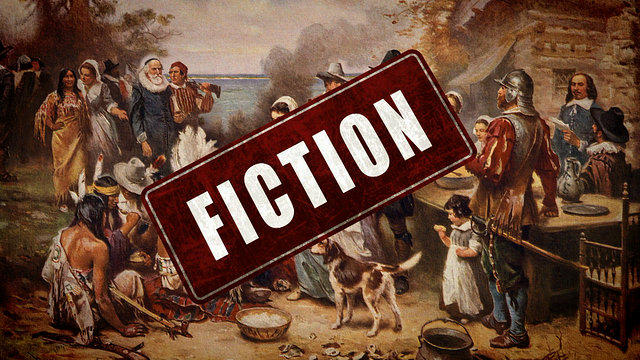
“Happy Thanksgiving!” we intone to one another, as we sit around the groaning dining room table and recite what we are thankful for. This uniquely US holiday is resplendent with images of turkeys, corn husks, orange pumpkins, Indian headdresses and the 1621 gathering of grateful Pilgrims and their feathered guests gathered around the table at Plymouth Rock.
This sanctimonious story is largely a myth, a point we are reminded of every year, but which, nevertheless, remains unchanged in popular culture. Children still act out the scene at schools, the Thanksgiving message is repeated from every church pulpit, politicians fervently reaffirm the theme and virtually every home celebrates the occasion with family and friends, traveling long distances at great environmental expense to carry on the sacred tradition.
When examined closely, Thanksgiving is a retelling of a story centuries older than the Pilgrims almost unsuccessful invasion of North America. It’s the story of a basic clash of cultures that started somewhere in the Fertile Crescent of Mesopotamia some 10,000 years ago, when Sumerian peoples began cultivating cereal crops and domesticating animals. Agriculture creates a change in human attitudes toward the land and the non-human animals that inhabit it. Since agriculture requires the investment of a great deal of energy and resources, and ties the human population to its fields, those fields must be protected from wild animals and plants, and other humans, that would compete with agriculturalists for the produce.
This led to the belief that the land “belongs” to the people as property, and, as owners of that property, humans have every right to do with it as they desire. Increased productivity led to increased population, which required more land to be cleared and planted and more animals domesticated, which resulted in more food available and more population increase.
The belief that the land is property owned by humans led to the religious belief that the land and the plants and animals, in fact the Earth and the Universe, were created by the Gods for human use, that the humans are the apex of evolution, and therefor humans have dominion over all of Creation exclusively for human occupation and use and in which to enjoy fruitfulness and multiplicity.
Fast forward to 1620, and we see a people on the land of Turtle Island who are unaware of this special relationship with the gods, who see themselves as an intricately connected part of the natural world and who control their own populations so as to remain within natural cycles of resource availability. They’ve occupied this continent for 10,000 years or so, without laying waste to the roundabout thereof, without destroying the natural habitat that supports them.
The Pilgrims decanted from the Mayflower on December 16, 1620, a frigid day in the middle of the Little Ice Age, not at Plymouth Rock, which was rolled into place by local entrepreneurs in the 19th Century, but at Plymouth Harbor. Their new home was chosen on the unoccupied site of a Native village, as the land surrounding it had already been cleared and planted in corn. The Pilgrims didn’t know at the time that the way for their arrival had been prepared for them by previous tiny European immigrants, invisible animalcules carried in the bodies of European fisherman who supplemented their catch by raiding Indian villages for slaves to be sold in European slave markets. The resulting plagues killed 90 to 95% of the Native population of eastern Turtle Island, leaving their settlement and agricultural sites open for occupation by the European interlopers.
The new occupants saw these plagues as a sign from their god that they were the chosen people and this land was provided by their god to do with as they pleased, regardless of the remaining Native inhabitants trying desperately to survive in the face of a major blow to their population and culture.
So our prayers of thanksgiving these days are for the deaths of millions of Native inhabitants of this continent, the destruction of hundreds of millions of acres of natural habitat, along with the plants and animals that occupied them, all to make way for our ancestors to shove aside the locals and allow our brand of civilization to move in and take over. We thank our god for creating us as masters of the Earth and the Universe and for providing all this for us to plunder.
A note of caution – as we celebrate this cultural myth, let’s not forget that Nature bats last, that all species on this planet are bound by the law of limited competition; that is, any species that practices unlimited growth, that guards its resources from use by others and that kills off all competition for resources, will inevitably decline and go extinct as it disrupts natural ecological relationships and outstrips available resources.
Let’s celebrate this day with thanksgiving for the wondrous diversity of all of life on this planet that makes it possible for us to live as one species among the many.
Discover more from We Live in the Natural World
Subscribe to get the latest posts to your email.
Well said! Happy Day of Giving Thanks regardless of it’s beginnings! Love to you and Jean.
LikeLike
Best Thanksgiving greeting received today – or ever for that matter. May the world catch up with your vision! Thanks, Michael.
LikeLike
Im a new visitor to your excellent site:
I was wondering if you are familiar with the very real phenomenon called The Wetiko Disease as described in the book Columbus & Other Cannibals by Jack Forbes.
LikeLike
No, I’m not. Please tell us about it!
LikeLike